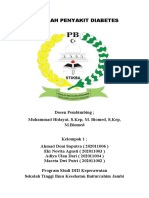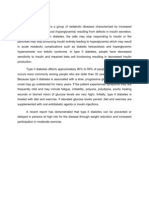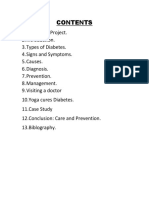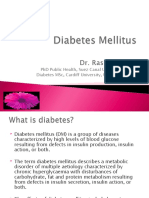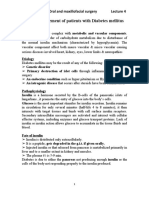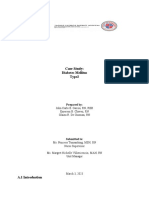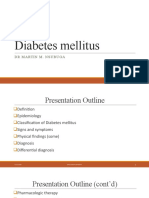Quiz 1
Quiz 1
Uploaded by
P PpCopyright:
Available Formats
Quiz 1
Quiz 1
Uploaded by
P PpOriginal Description:
Original Title
Copyright
Available Formats
Share this document
Did you find this document useful?
Is this content inappropriate?
Copyright:
Available Formats
Quiz 1
Quiz 1
Uploaded by
P PpCopyright:
Available Formats
1.
The risk factors for type 1 diabetes include all of the following except:
1.Diet
2.Genetic
3.Autoimmune
4.Environmental
3. Risk factors for type 2 diabetes include all of the following except:
1. Advanced age
2. Obesity
3. Smoking
4. Physical inactivity
4. What percentage of women with gestational diabetes is diagnosed with type 2 diabetes
following pregnancy?
1. 25%-30%
2. 5%-10%
3. <5%
4. 20%-25%
7. Diabetics are at increased risk of heart disease if they also:
1. Smoke
2. Have high HDL cholesterol levels
3. Take aspirin
4. Consume a high-fiber diet
8. Blood sugar is well controlled when Hemoglobin A1C is:
1. Below 7%
2. Between 12%-15%
3. Less than 180 mg/dL
4. Between 90 and 130 mg/dL
9. Excessive thirst and volume of very dilute urine may be symptoms of:
1. Urinary tract infection
2. Diabetes insipidus
3. Viral gastroenteritis
4. Hypoglycemia
10. Among female children and adolescents, the first sign of type 1 diabetes may be:
1. Rapid weight gain
2. Constipation
3. Genital candidiasis
4. Insomnia
11. Untreated hyperglycemia may lead to all of the following complications except:
1. Hyperosmolar syndrome
2. Vitiligo
3. Diabetic ketoacidosis
4. Coma
12. Hyperinsulinemia may be caused by all of the following except:
1. An insulinoma
2. Nesidioblastosis
3. Insulin resistance
4. Type 1 diabetes
16. Proliferative retinopathy is often treated using:
1. Tonometry
2. Fluorescein angiogram
3. Antibiotics
4. Laser surgery
17. Which of the following diabetes drugs acts by decreasing the amount of glucose produced by
the liver?
1. Sulfonylureas
2. Meglitinides
3. Biguanides
4. Alpha-glucosidase inhibitors
18. The benefits of using an insulin pump include all of the following except:
1. By continuously providing insulin they eliminate the need for injections of
insulin
2. They simplify management of blood sugar and often improve A1C
3. They enable exercise without compensatory carbohydrate consumption
4. They help with weight loss
20. Diabetic neuropathies are diagnosed using all of the following except:
1. Nerve conduction studies or electromyography
2. Ultrasound
3. Foot examinations
4. Minnesota Mutiphasic Personality inventory (MMPI)
ANSWERS
1. A
Type 1 diabetes is a primary failure of pancreatic beta cells to produce insulin. It
primarily affects children and young adults and is unrelated to diet.
3. C
Additional risk factors for type 2 diabetes are a family history of diabetes,
impaired glucose metabolism, history of gestational diabetes, and race/ethnicity.
African-Americans, Hispanics/Latinos, Asian Americans, Native Hawaiians, Pacific
Islanders, and Native Americans are at greater risk of developing diabetes than
whites.
4. B
African-American, Hispanic/Latina and Native American women are at greater risk
of developing gestational diabetes than are white women. Women who
experience gestational diabetes are at increased risk of developing diabetes
during the decade following pregnancy.
7. A
Diabetics who smoke are at greater risk of developing heart disease because
both diabetes and smoking act to narrow blood vessels. Smoking also is
associated with increased risk of eye problems and may compromise circulation
to the legs.
8. A
A1c measures the percentage of hemoglobin that is glycated and determines
average blood glucose during the two to three months prior to testing. Used as a
diagnostic tool, A1C levels of 6.5% or higher on two tests indicate diabetes. A1C
of 6% to 6.5% is considered prediabetes.
9. B
Diabetes insipidus is a condition in which the kidneys are unable to conserve
water, often because there is insufficient antidiuretic hormone (ADH) or the
kidneys are unable to respond to ADH. Although diabetes mellitus may present
with similar symptoms, the disorders are different. Diabetes insipidus does not
involve hyperglycemia.
10. C
The signs and symptoms that suggest type 1 diabetes include excessive thirst,
hunger, urination, weight loss, fatigue, irritability, blurred vision, and infection
with candida albicans (also known as yeast infections).
11. B
Excessively high blood sugar or prolonged hyperglycemia can cause diabetic
ketoacidosis, the condition in which the body breaks down fat for energy and
ketones spill into the urine. Diabetic hyperosmolar syndrome occurs when blood
sugar is excessively high and available insulin is ineffective. In this case, the body
cannot use glucose or fat for energy and glucose is excreted in the urine. Without
immediate medical attention, both conditions may result in coma or death.
12. D
Hyperinsulinemia indicates a difficulty in blood sugar regulation; the pancreas is
working to produce enough insulin to regulate blood sugar. Hyperinsulinemia
may be cause by a tumor of insulin-producing cells (an insulinoma), excessive
numbers of insulin producing cells (nesidioblastosis), or insulin resistance.
16. D
Scatter laser treatment is used to shrink abnormal blood vessels in an effort to
preserve vision. When there is significant bleeding in the eye, it is removed in a
procedure known as vitrectomy. Tonometry is a diagnostic test that measures
pressure inside the eye. A fluorescein angiogram is a diagnostic test that traces
the flow of dye through the blood vessels in the retina; it is used to detect
macular edema.
17. C
Biguanides, such as metformin, lower blood glucose by reducing the amount of
glucose produced by the liver. Sulfonylureas and Meglitinides stimulate the beta
cells of the pancreas to produce more insulin. Alpha-glucosidase inhibitors block
the breakdown of starches and some sugars, which helps to reduce blood
glucose levels
18. D
Using an insulin pump has many advantages, including fewer dramatic swings in
blood glucose levels, increased flexibility about diet, and improved accuracy of
insulin doses and delivery; however, the use of an insulin pump has been
associated with weight gain.
20. D
Nerve conduction studies assess transmission of electrical signals through nerves
and electromyography evaluates nerve transmission to muscles. Ultrasound can
assess the responsivity and function of internal organs that may be compromised
by neurological damage. Foot exams help to assess peripheral neuropathy and to
ensure the integrity of skin. The MMPI is a psychological test and is not used to
assess diabetic neuropathy.
You might also like
- Bodylastics User Manual 2011 Color PDFDocument76 pagesBodylastics User Manual 2011 Color PDFjpNo ratings yet
- 4 Diabetes Nutrition Care PlanDocument5 pages4 Diabetes Nutrition Care Planapi-309275032No ratings yet
- A Survey On The Nutritional Status ofDocument56 pagesA Survey On The Nutritional Status oflucasNo ratings yet
- Building Legendary Shoulders e Book FinalDocument43 pagesBuilding Legendary Shoulders e Book FinalAbban Siddiqui76% (25)
- DM Questions ReviewDocument5 pagesDM Questions ReviewJayson Britania MayugaNo ratings yet
- Diabetes MiletusDocument26 pagesDiabetes Miletus7mymailboxNo ratings yet
- Physiology and Causes of DiabatesDocument7 pagesPhysiology and Causes of DiabatesasaadsarfrazNo ratings yet
- DiabetesDocument10 pagesDiabetesFatima El HassouniNo ratings yet
- Diabetes PPT FianlDocument31 pagesDiabetes PPT FianlUqba Mishal100% (1)
- DP DP DPDocument23 pagesDP DP DPAkshay VenkyNo ratings yet
- Makalah Penyakit DiabetesDocument6 pagesMakalah Penyakit DiabetesTaju'al Taju'alNo ratings yet
- Grp.10 DiabetesDocument15 pagesGrp.10 DiabetesVanessa JanneNo ratings yet
- ReadingsDocument24 pagesReadingsBryant Riego IIINo ratings yet
- Session 27 Diabetes M - 1Document47 pagesSession 27 Diabetes M - 1Kuchby MskudeNo ratings yet
- Sheldonsmith Introductiontodiabetes 121010154423 Phpapp02Document47 pagesSheldonsmith Introductiontodiabetes 121010154423 Phpapp02THARINDUNo ratings yet
- Bio Project FinalisedDocument24 pagesBio Project FinalisedLakshmi SenthilkumarNo ratings yet
- DiabetesDocument34 pagesDiabetesqurat-ul-ain.sonNo ratings yet
- Diabetes 1Document67 pagesDiabetes 1Manny HermosaNo ratings yet
- Covid-19 and Diabetes: Chandan Kumar 3rd YEARDocument19 pagesCovid-19 and Diabetes: Chandan Kumar 3rd YEAROlga GoryachevaNo ratings yet
- Diabetes Mellitus 1Document19 pagesDiabetes Mellitus 1shamma shahulhameedNo ratings yet
- DIABETES CorrectedDocument16 pagesDIABETES CorrectedBlaise PascalNo ratings yet
- DiabetesDocument14 pagesDiabetesBocah JomloNo ratings yet
- Diabetes Mellitus Is A Group of Metabolic Diseases Characterized byDocument67 pagesDiabetes Mellitus Is A Group of Metabolic Diseases Characterized byBivek TimalsinaNo ratings yet
- DIABETESDocument7 pagesDIABETESSweata DasNo ratings yet
- Bio Project On DiabetesDocument17 pagesBio Project On DiabetesNishant KumarNo ratings yet
- GroupDocument38 pagesGroupanfalalamin9915No ratings yet
- Pediatric DMDocument39 pagesPediatric DMmy Lord JesusNo ratings yet
- Diabetes: Oral Health TopicsDocument9 pagesDiabetes: Oral Health TopicsAndrei StamateNo ratings yet
- Diabetes Mellitus, Disorder Of: Institute For BiotechnologyDocument10 pagesDiabetes Mellitus, Disorder Of: Institute For BiotechnologyAndre Jonathan Siàńsàkà IINo ratings yet
- Bka Case FinalDocument26 pagesBka Case FinalJayson SorianoNo ratings yet
- Diabetes MellitusDocument10 pagesDiabetes Mellitusjoeln_9No ratings yet
- Diabetes Mellitus MCQSDocument12 pagesDiabetes Mellitus MCQSshaukatkhan0798No ratings yet
- DM Case StudyDocument39 pagesDM Case StudyShella Mae Usquisa100% (2)
- IntroductionDocument13 pagesIntroductionSaadNo ratings yet
- DiabetesDocument10 pagesDiabetesFatima El HassouniNo ratings yet
- An Introduction To Diabetes Mellitus: ("Sweet Flow")Document31 pagesAn Introduction To Diabetes Mellitus: ("Sweet Flow")Subramaniam RamanNo ratings yet
- Dr. Rasha Salama: PHD Public Health, Suez Canal University, Egypt Diabetes MSC, Cardiff University, United KingdomDocument37 pagesDr. Rasha Salama: PHD Public Health, Suez Canal University, Egypt Diabetes MSC, Cardiff University, United Kingdomdwi istutikNo ratings yet
- DIABETESDocument5 pagesDIABETESmariumNo ratings yet
- DiabetesDocument2 pagesDiabetesNick BantoloNo ratings yet
- Diabetes MillitusDocument4 pagesDiabetes MillitusMuniza KhaliqNo ratings yet
- Dental Management of Patients With Diabetes MellitusDocument8 pagesDental Management of Patients With Diabetes Mellitusاحمد سلامNo ratings yet
- Diabetes MellitusDocument44 pagesDiabetes MellituslkristinNo ratings yet
- Diabetes Mellitus IIDocument20 pagesDiabetes Mellitus IIMa R Dy100% (1)
- Assignmetn Stem CellDocument13 pagesAssignmetn Stem CellPeeyushNo ratings yet
- Diabetes MelitusDocument14 pagesDiabetes MelitusDewa Ayu Pradnya DewiNo ratings yet
- Diabetes MellitusDocument37 pagesDiabetes MellitusEstrera Ruschelle A.No ratings yet
- Case Study in DMDocument34 pagesCase Study in DMKathrina Marie B. BinaraoNo ratings yet
- PharmacologyDocument16 pagesPharmacologyRakshita JainNo ratings yet
- Diabetes in PregnancyDocument14 pagesDiabetes in Pregnancywalaaahmed213No ratings yet
- Diabetes Mellitus CommunityDocument23 pagesDiabetes Mellitus CommunityJoychukzNo ratings yet
- Diabetes Mellitus HospitalDocument29 pagesDiabetes Mellitus HospitalgegeNo ratings yet
- DM PresentationDocument28 pagesDM PresentationmymommywowNo ratings yet
- Sapna ProjDocument21 pagesSapna ProjBunny RajNo ratings yet
- Diabetes Mellitus Case StudyDocument5 pagesDiabetes Mellitus Case StudyRainier Rhett Concha86% (7)
- Diabetes MellitusDocument27 pagesDiabetes Mellitusmburu. hNo ratings yet
- Diabetes Melitus Party 1Document18 pagesDiabetes Melitus Party 1fadhiliNo ratings yet
- Diabetes Mellitus Type2: Case StudyDocument48 pagesDiabetes Mellitus Type2: Case StudyJohn Carlo GarciaNo ratings yet
- Diabetes Mellitus LECTURE Yr IIIDocument27 pagesDiabetes Mellitus LECTURE Yr IIIMwanja Moses100% (1)
- Dad ADocument107 pagesDad Abammu21No ratings yet
- Diabetes Mellitus Type 2Document20 pagesDiabetes Mellitus Type 2Collective CompanyNo ratings yet
- Diabetes MellitusDocument3 pagesDiabetes MellitusRizz D. Santos-TorresNo ratings yet
- A Practical Guide To Diagnosing Type 2 DiabetesDocument4 pagesA Practical Guide To Diagnosing Type 2 Diabeteselena_bautista_3No ratings yet
- Conquering Diabetes: Fenugreek Success in Regulating Blood Sugar LevelsFrom EverandConquering Diabetes: Fenugreek Success in Regulating Blood Sugar LevelsNo ratings yet
- Absolute Cardiovascular Risk Assessment: DiseaseDocument6 pagesAbsolute Cardiovascular Risk Assessment: DiseaseCharlene GrajeraNo ratings yet
- 5th Year 112 PediatricsDocument12 pages5th Year 112 PediatricsAmjad A. Amir100% (2)
- Nutri5 PDFDocument3 pagesNutri5 PDFfkkfoxNo ratings yet
- Body Movements and CardiorespiratoryDocument11 pagesBody Movements and CardiorespiratoryRaymond LuberiaNo ratings yet
- Unit 06 Work Book AkDocument1 pageUnit 06 Work Book AkkillgoliatNo ratings yet
- Leshan Broniszewski-Burlingham Case Presentation 3 2017Document30 pagesLeshan Broniszewski-Burlingham Case Presentation 3 2017api-351417791No ratings yet
- Essay On Healthy EatingDocument10 pagesEssay On Healthy EatingAini Ulis100% (2)
- Pre Test INTRUCTION: Encircle The Correct AnswerDocument2 pagesPre Test INTRUCTION: Encircle The Correct AnswerAnnie Lyne Tubban VergaraNo ratings yet
- Type2 Diabetes HandoutDocument1 pageType2 Diabetes Handouthendra_darmawan_4No ratings yet
- Rheumatoid ArthritisDocument32 pagesRheumatoid ArthritisWoro Nugroho100% (5)
- Issue 6 June 2011 - Conveyor Belt Tensioning and Take Up Guide PDFDocument2 pagesIssue 6 June 2011 - Conveyor Belt Tensioning and Take Up Guide PDFmkiani2No ratings yet
- FBFM Pre TrainingDocument14 pagesFBFM Pre TrainingMargarita Kotova100% (7)
- Fast Food Less Affordable A Solution To Obesity: Article WritingDocument5 pagesFast Food Less Affordable A Solution To Obesity: Article WritingVina LangidenNo ratings yet
- Outlining A TextDocument6 pagesOutlining A TextJulieSanchezErsandoNo ratings yet
- Keeping Healthy Conversation Topics Dialogs Reading Comprehension - 82060Document4 pagesKeeping Healthy Conversation Topics Dialogs Reading Comprehension - 82060shaimaaNo ratings yet
- Ebook Elitefts Ptw32Document339 pagesEbook Elitefts Ptw32Machel Buchanan100% (5)
- NCP For DMDocument14 pagesNCP For DMLynzzky Virtudes AbranNo ratings yet
- Keane-Technical Methods of Chemical Analysis Vol 3 PT 1 1908Document582 pagesKeane-Technical Methods of Chemical Analysis Vol 3 PT 1 1908RonLaytonNo ratings yet
- Health Education - CholelithiasisDocument12 pagesHealth Education - Cholelithiasismohamad dildarNo ratings yet
- Turmeric Potent Cancer CuresDocument169 pagesTurmeric Potent Cancer Curestriuneenergy100% (3)
- Fruit and VegetablesDocument5 pagesFruit and VegetablesclaraNo ratings yet
- Fito Company Frutarom Company OverviewDocument40 pagesFito Company Frutarom Company OverviewprocopiodelllanoNo ratings yet
- Exercise and Obesity Thesis StatementDocument5 pagesExercise and Obesity Thesis Statementsprxzfugg100% (2)
- Excerpt From The Complete Book of Juicing, Revised and Updated by Dr. Michael T. MurrayDocument23 pagesExcerpt From The Complete Book of Juicing, Revised and Updated by Dr. Michael T. MurrayThe Recipe Club50% (4)
- Energy Balance and Body Composition PPT 2Document5 pagesEnergy Balance and Body Composition PPT 2Nisa MustafaNo ratings yet
- Progressive Calisthenics Strength TrainingDocument47 pagesProgressive Calisthenics Strength Trainingcavaleramax100% (2)










